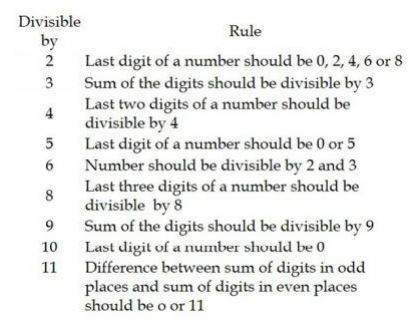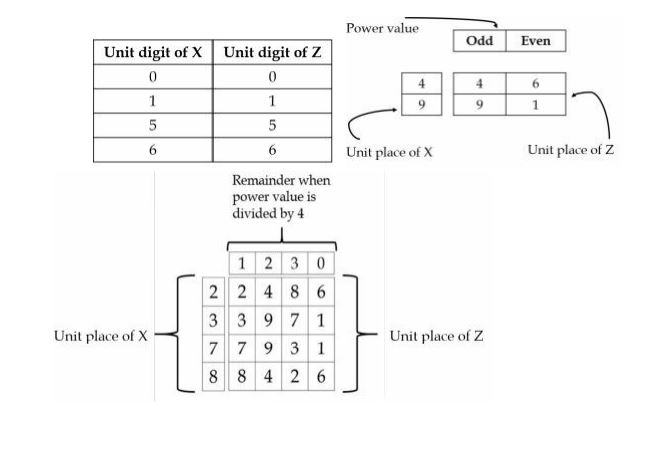Shortcut -Number Systems
Divisibility Rules:

Divisibility rule for composite numbers:
If a number is a multiple of ‘x’ and ‘y’, then it is divisible by LCM of
(x, y).
30 is the LCM of (2, 3 and 5). So all the multiples of 30 are divisible by 2, 3 and 5.
Question:
Which of the following numbers is divisible by both 5 and 9? 1115, 11115, 111115, 1111115
Answer:11115 – It is divisible by 5 and 9.
Shortcut -Number Systems
Finding largest four digit number that is divisible by certain numbers.
Step 1:LCM of the divisors
Step
2:Remainder of 10000/LCM
Step 3:10000-Remainder=Answer
Question:
Find the largest number that leaves
1. Remainder 0
when divided by 12, 15 and 20.
2. Remainder 2 when divided by 12, 15 and 20.
3. Remainder 9, 12 and 17 when divided by 12, 15 and 20 respectively.
1. Remainder 0:
LCM(12, 15, 20) = 60
Remainder(10000/60) = 40
10000 – 40 = 9960.
The largest number that leaves remainder 0 =
9960
2. Remainder 2:
9960 + 2 = 9962 is the largest 4 digit number that leaves remainder 2 when
divided by 12, 15 and 20.
3. Remainder 9, 12 and 17:
Difference between divisor and remainder = 3.
9960 – 3 = 9957 is the largest 4 digit number that leaves remainder 9, 12 and
17 when divided by 12, 15 and 20.
Shortcut -Number Systems
Finding unit digit of a number with certain
power.
The expression will be in the form $X^{Y} = Z$

Shortcut -
Number Systems
Remainder Concept:
Remainder($\dfrac{A\times B \times C}{K})=R
(\dfrac{A}{K})\times R(\dfrac{B}{K})\times R (\dfrac{C}{K})$
This concept is also applicable if the numbers in the numerator are added or
subtracted.
Question:
Find the remainder when 212 x 313 x 414 is divided by 5.
Answer: Using the above concept we
can find the remainder for each term and then we can multiply.
R(212/5) = 2
R(313/5) = 3
R(414/5) = 4
2 x 3 x 4 = 24
The value we got is still greater
than 5, so again divide it and find the remainder.
R(24/5) = 4
The remainder of the expression is = 4
Type 1:Addition or subtraction series (Difference series)
Case 1:Simple addition or subtraction (+N/-N) or Arithmetic progression
In this type of series a number is incremented/decremented by a fixed value.
Eg:1) 5,9,13,17,21,...(A number is incremented by 4)
2)11,17,23,29,35,....(A umber is incremented by 6)?
Case 2: Series Addition or Subtraction
In this type of series next number is incremented or decremented by an other series.
Eg:1) 2,5,9,14,20,27,35,...(Number is incremented by 3,4,5,6,7,...)
Eg:2) 13,17,25,37,53,...(Number is incremented by 4,8,12,16,...)
Eg:3)841,821,796,766,731,...(Number is decremented by 20,25,30,35,...)
Type 2:Multiplication or Division Series
Case 1:Simple Multiplication or Division (*N/$\div$N) or Geometrical Progression
In this type of number s ries a number is either multiplied by a ixed number or divided by a fixed number.
Eg: 1)2,6,18,54,162,486,1454,...(A number is multiplied by 3)
Eg:2)6,12,24,48,96,192,384,...(A number is multiplied by 2)
Eg:3)4096,1024,256,64,16,4,....(A number is multiplied by 4)
Case 2:Multiplication or Division by Arithmetic series
In this type of series a number is multiplied or divided by an arithmetic series.
Eg:1)1,1,2,6,24,120,720,....(Numbers are multiplied by 1,2,3,4,5,6,....)
Eg:2)5040,720,120,24,,...(Numbers are divided by 7,6,5,4,....)
Case 3:Mixed Multiplication or Division and Addition or Subtraction series:
In this type of series a number is multiplied or divided by afixed number and other number is added/subtracted to get next number of the series.
Eg 1:1,3,7,15,31,63,...(series is achieved by *2+1)
Eg 2:1,2,6,21,88,445,...(series is achieved by *1+1,*2+2,*3+3,...)
Eg 3:1,4,11,26,57,120,...(Series is achieved by *2+2,*2+3,*2+4,...)
Type 3: Prime number series:(A prime number has only two factors that is 1 and the number itself)
Case 1:Simple Prime number series :
This type of series is consecutive prime number series.
Eg 1:3,5,7,11,13,17,...(given series is a consecutive prime number series)
Eg 2:3,5,11,19,37,...(Here 5 is first prime number after 3,11 is second prime number after 5,19 is third prime number after 11 and so on)
Case 2:Prime number addition/subtraction series:
In this type of series next number is addition or subtraction of prime number series.
Eg 1:1,4,9,16,27,40,....(number is incremented by prime number series 3,5,7,11,13,...)
Eg 2:234,231,226,219,208,...(number is decremented by prime number series 3,5,7,11,13,..)
Case 3:Prime number multiplication and division series:
In this type of series next number is multiplication or division of prime number series.
Eg 1:1,3,15,105,1155,15015,....(Number is multiplied by prime number series 3,5,7,11,13,...)
Eg 2:255255,15015,1155,105,15,...(Number is divided by prime number series 17,13,11,7,..)
Type 4:$N^2$ series
Case 1:Simple $N^2$ series
This type of series includes square of numbers.
Eg.1 1,4,9,16,25,36,49,....(Numbers are square of 1,2,3,4,5,...)
Eg.2 1,9,25,49,81,...(Numbers are squares of consecutive odd numbers 1,3,5,7,....)
Case 2:$N^2$ series with addition or subtraction
This type of series include $N^2$ series with addition or subtraction with fixed number or number series.
Eg.1 2,5,10,17,26,...(series is ($N^2 + 1$ )
Eg.2 0,2,6,12,20,....(series is ($N^2-N$)
Case 3: Addition or subtraction of $N^2$ series.
In this type of series $N^2$ is either added or subtracted from a number to form the series
Eg. 154,155,164,189,238,319,...(1,9,25,49,...are added to form the series )
Eg. 884,859,823,774,710,...(25,36,49,64,...are subtracted to form the series )
Type 5: $N^3$ series
Case 1:Simple $N^3$ series
This type of series include $N^2$ series with addition or subtraction with fixed number or number series.
Eg. 1,8,27,64,125,216,343,...(Numbers are cubes of 1,2,3,4,5,..)
Eg. 4,64,216,512,...(Numbers are cubes of consecutive even numbers 2,4,6,8,..)
Case 2:$N^3$ series with addition or subtraction
This type of series include $N^2$ series with adition or subtraction with fixed number or number series .
Eg. 0,7,26,63,124,...(series is ($N^3-1)
Eg. 2,10,30,68,130,....(Series is($N^3+N))
Type 6:Miscellaneous series
Case 1:Combination of two series:
When a series is combination of two series.
Eg. 1,4,4,8,7,16,10,32,13,...(This series is combination of two series (i) 1,4,7,10,...(ii)4,8,16,32,...)
Eg. 42,61,45,56,48,51,46,...(This series is combination of two series (i)42,45,48,51,...(ii)61,56,51,46,...)
Case 2:Duel arithmetic operation series:
When more than one arithmetic operations are performed
Eg. 9,27,31,155,161,1127,..(This pattern is *3,+4,*5,+6,*7..)
Eg. 41,43,38,40,35,37,32,...(This pattern is +2,-5,+2,-5,..)
